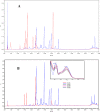ANALYSIS OF PHENOLIC AND FLAVONOIDS OF WILD EPHEDRA ALATA PLANT EXTRACTS BY LC/PDA AND LC/MS AND THEIR ANTIOXIDANT ACTIVITY
- PMID: 28573229
- PMCID: PMC5446436
- DOI: 10.21010/ajtcam.v14i2.14
ANALYSIS OF PHENOLIC AND FLAVONOIDS OF WILD EPHEDRA ALATA PLANT EXTRACTS BY LC/PDA AND LC/MS AND THEIR ANTIOXIDANT ACTIVITY
Abstract
Background: Ephedra is among Palestinian medicinal plants that are traditionally used in folkloric medicine for treating many diseases. Ephedra is known to have antibacterial and antioxidant effects. The goal of this study is to evaluate the antioxidant activity of different extracts from the Ephedra alata plant growing wild in Palestine, and to analyze their phenolic and flavonoid constituents by HPLC/PDA and HPLC/MS.
Materials and methods: Samples of the Ephedra alata plant grown wild in Palestine were extracted with three different solvents namely, 100% water, 80% ethanol, and 100% ethanol. The extracts were analyzed for their total phenolic content (TPC), total flavonoid content (TFC), antioxidant activity (AA), as well as phenolic and flavonoids content by HPLC/PDA/MS.
Results: The results revealed that the polarity of the extraction solvent affects the TPC, TFC, and AA of extracts. It was found that both TPC and AA are highest for plant extracted with 80% ethanol, followed by 100% ethanol, and finally with 100% water. TFC however was highest in the following order: 100% ethanol > 80% ethanol > water. Pearson correlation indicated that there is a significant correlation between AA and TPC, but there is no correlation between AA and TFC. Simultaneous HPLC-PDA and UHPLC-MS analysis of the ethanolic plant extracts revealed the presence of Luteolin-7-O-glucuronide flavone, Myricetin 3-rhamnoside and some other major polyphenolic compounds that share myricetin skeleton.
Conclusion: Ephedra alata extract is rich in potent falvonoid glycosidic compounds as revealed by their similar overlaid UV-Vis spectra and UHPLC-MS results. On the basis of these findings, it is concluded that Ephedra alata constitutes a natural source of potent antioxidants that may prevent many diseases and could be potentially used in food, cosmetics, and pharmaceutical products.
Keywords: Ephedra Alata; HPLC; LC/MS; antioxidant activity; flavonoid content; phenolic content.
Figures





Similar articles
-
Determination of flavonoids, polyphenols and antioxidant activity of Tephrosia purpurea: a seasonal study.J Integr Med. 2016 Nov;14(6):447-455. doi: 10.1016/S2095-4964(16)60276-5. J Integr Med. 2016. PMID: 27854196
-
Investigation of the phytochemical profiling and antioxidant, anti-diabetic, anti-inflammatory, and MDA-MB-231 cell line antiproliferative potentials of extracts from Ephedra alata Decne.Sci Rep. 2024 Aug 6;14(1):18240. doi: 10.1038/s41598-024-65561-9. Sci Rep. 2024. PMID: 39107351 Free PMC article.
-
LC-ESI-QTOF-MS/MS characterization of phenolic compounds from Prosopis farcta (Banks & Sol.) J.F.Macbr. and their potential antioxidant activities.Cell Mol Biol (Noisy-le-grand). 2021 Jan 31;67(1):189-200. doi: 10.14715/cmb/2021.67.1.28. Cell Mol Biol (Noisy-le-grand). 2021. PMID: 34817348
-
Effect of solvent polarity on the Ultrasound Assisted extraction and antioxidant activity of phenolic compounds from habanero pepper leaves (Capsicum chinense) and its identification by UPLC-PDA-ESI-MS/MS.Ultrason Sonochem. 2021 Aug;76:105658. doi: 10.1016/j.ultsonch.2021.105658. Epub 2021 Jul 2. Ultrason Sonochem. 2021. PMID: 34242865 Free PMC article. Review.
-
Blackthorn-A Valuable Source of Phenolic Antioxidants with Potential Health Benefits.Molecules. 2023 Apr 14;28(8):3456. doi: 10.3390/molecules28083456. Molecules. 2023. PMID: 37110690 Free PMC article. Review.
Cited by
-
Green Synthesis of Gold, Iron and Selenium Nanoparticles Using Phytoconstituents: Preliminary Evaluation of Antioxidant and Biocompatibility Potential.Molecules. 2022 Feb 16;27(4):1334. doi: 10.3390/molecules27041334. Molecules. 2022. PMID: 35209121 Free PMC article.
-
A New Highlight of Ephedra alata Decne Properties as Potential Adjuvant in Combination with Cisplatin to Induce Cell Death of 4T1 Breast Cancer Cells In Vitro and In Vivo.Cells. 2020 Feb 4;9(2):362. doi: 10.3390/cells9020362. Cells. 2020. PMID: 32033130 Free PMC article.
-
The role of Algerian Ephedra alata ethanolic extract in inhibiting the growth of breast cancer cells by inducing apoptosis in a p53- dependent pathway.Saudi J Biol Sci. 2023 Jun;30(6):103650. doi: 10.1016/j.sjbs.2023.103650. Epub 2023 Apr 18. Saudi J Biol Sci. 2023. PMID: 37152301 Free PMC article.
-
Pharmacological evaluation and phytochemical profiling of butanol extract of L. edodes with in- silico virtual screening.Sci Rep. 2024 Mar 8;14(1):5751. doi: 10.1038/s41598-024-56421-7. Sci Rep. 2024. PMID: 38459108 Free PMC article.
-
Ephedrae Herba: A Review of Its Phytochemistry, Pharmacology, Clinical Application, and Alkaloid Toxicity.Molecules. 2023 Jan 9;28(2):663. doi: 10.3390/molecules28020663. Molecules. 2023. PMID: 36677722 Free PMC article. Review.
References
-
- Alali FQ, Tawaha K, El-Elimat T, Syouf M, El-Fayad M, Abulaila K, Nielsen SJ, Wheaton WD, Falkinham J. O, III, Oberlies NH. Antioxidant activity and total phenolic content of aqueous and methanolic extracts of Jordanian plants: an ICBG project’. Natural Product Research. 2007;21:1121–1131. - PubMed
-
- Apak R, Guclu K, Ozyurek M, Celik SE. Mechanism of antioxidant capacity assays and the CUPRAC (cupric ion reducing antioxidant capacity) assay. Microchim. Acta. 2008;160:413–419.
-
- Benzie IF.F, Strain JJ. Ferric reducing/antioxidant power assay: Direct measure of total antioxidant activity of biological fluids and modified version for simultaneous measurement of total antioxidant power and ascorbic acid concentration. Methods In Enzymology. 1999;299:15–27. - PubMed
-
- Brand-Williams W, Cuvelier ME, Berset C. Use of free radical method to evaluate antioxidant activity. Lebensm. Wiss. Technol. 1995;28:25–30.
MeSH terms
Substances
LinkOut - more resources
Full Text Sources
Other Literature Sources
Medical
